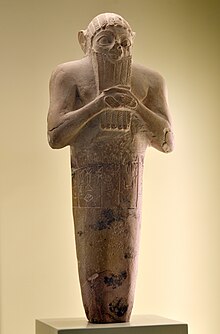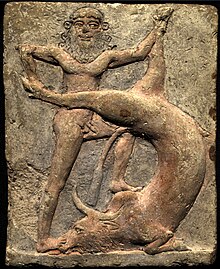Anu
[24] Xianhua Wang points out that in the Early Dynastic period, the rulers who mention Anu in the inscriptions and refer to him as lugal kur-kur, "king of the lands," seem to be connected with either Ur or Uruk, while elsewhere the same epithet designates Enlil instead.
[31] They typically appear alongside the other seven major celestial bodies which were known to Mesopotamian astronomers in the late first millennium BCE: the sun, the moon, and the planets Nebēru (Jupiter), Dilbat (Venus), Šiḫṭu (Mercury), Kayamānu (Saturn), and Ṣalbatānu (Mars).
[34] It is attested on some kudurru (boundary stones),[34] where it is typically present in the upper half of the decoration, below the symbols of Ishtar, Shamash and Sin, who were depicted on the very top of such monuments due to representing celestial bodies.
[51] An inscription on a votive figurine of king Lugal-kisalsi (or Lugal-giparesi), who ruled over Uruk and Ur in the twenty-fourth century BCE, refers to Nammu as the wife of Anu.
[75] However, according to Paul-Alain Beaulieu it most likely should simply be read as the Akkadian phrase dIl Amurrim, "the god of Amurru," as indicated by a Hurrian translation known from a bilingual text from Emar, de-ni a-mu-ri-we, which has the same meaning.
[86] It is possible that in the late first millennium BCE attempts at syncretizing Ishtaran and Anu were made during a period of cooperation between the theologians from Uruk, Nippur and Der, but direct evidence is presently lacking.
[109] Further attested pairs of deities regarded as ancestors of Anu include Egur and Gara, whose character is unknown,[47] Lahmu and Lahamu, derived from the name of a type of aquatic mythical creature,[47] two deities whose names were written logographically as dALAM possibly representing another of the known pairs or associated with the underworld,[110] and Enurulla and Ninurulla, the "lord" and "lady" of the "primeval city," whose inclusion in Anu's family tree most likely reflected "the importance of the city in ancient Mesopotamian thought.
[1] The god list An = Anum refers to Nammu as the "mother who gave birth to Heaven and Earth," dama-tu-an-ki, but as noted by Frans Wiggermann, the terms an and ki were most likely understood collectively in this case.
[116] However, according to Julia Krul, it is impossible to tell how widespread the recognition of this aspect of his character was, and broad statements about Anu being outright identified with deities of the underworld in the theology of Seleucid Uruk should be generally avoided.
[131] In the context of the so-called "antiquarian theology" relying largely on god lists, which developed in Uruk under Achaemenid and Seleucid rule,[132] he was fully identified with Ninshubur and thus became Anu's sukkal and one of the eighteen major deities of the city.
[5] Julia Krul points out authors who propose it do not clarify whether they mean if "the Seleucids made such an equation themselves (...), or that the Urukean priest-scholars convinced their new kings of the similarity between the two gods (...), or even that they genuinely believed that Anu and Zeus were the same.
[149] It is often assumed that the so-called "White Temple," which dates back to the Uruk IV period (3500–3100 BCE) was his original cult center, and it is even sometimes referred to as the "Anu ziggurat" in modern literature.
[151] There is also no indication that Eanna, "House of Heaven" (Sumerian: e2-anna; Cuneiform: 𒂍𒀭 E2.AN[a]), the main temple of Uruk in historical times, was originally the abode of Anu alone, as sometimes proposed in the past.
[154] Simultaneously Anu does not play any major role and Inanna is the sole owner of Eanna in the myths about Enmerkar and Lugalbanda, other legendary kings of Uruk commonly referenced in Mesopotamian literature.
[181][182] While multiple Neo-Babylonian archives from Uruk have been excavated and published, so far research revealed only a small number of people bearing theophoric names invoking Anu before the reign of Nabonidus, with a total of five being mentioned in known documents according to the highest estimate.
[185] Documents from the reign of Darius I show further growth, though names invoking chiefly northern Babylonian deities, as well as Nanaya, Ishtar and Shamash (from Larsa) remain numerous.
[186] After a rebellion of the northern Babylonian cities against Persian rule in 484 BCE, this king seemingly reorganized the traditional structure of Mesopotamian clergy, and while Uruk did not rebel, it was not exempt from changes.
[187] It has been proposed that the older priests, who were often connected to the northern cities and were predominantly involved in the cult of Ishtar, were replaced by a number of powerful local families dedicated to Anu.
[187] Julia Krul suggests that their members likely planned to expand the scope of Anu's cult in the Neo-Babylonian period already, but were unable to do so due to the interests of the kings, who favored Marduk as the head of the pantheon.
[9] At the same time, he considers it possible that Achaemenid administration encouraged the worship of Anu, viewing it as a way to limit the influence of Babylon and its elites on inhabitants of other Mesopotamian cities.
[142] Beaulieu instead proposes that Anu's rise was in part inspired by a network of syncretism associations between him, Anshar, who was also worshiped in Uruk, and the Assyrian head god Ashur, who in Assyria could be identified with the latter.
[181] Beaulieu himself admits that most of the evidence which might support his theory might instead simply indicate that both the elevation of Assur and Anu relied on similar preexisting models, such as the theology centered on Enlil.
[200] A resource commonly employed by the theologians and antiquarians working on the elevation of Anu were god lists, such as An = Anum, which provided the evidence needed to justify both this change and other examples of restructuring the city pantheon.
[201] While it is assumed that religious activity in Uruk continued through the late Seleucid and early Parthian periods, a large part of the Bīt Rēš complex was eventually destroyed by a fire.
[202] According to a Greek inscription dated to 111 CE, the deity worshipped in Uruk in the early first millennium was apparently otherwise unknown Gareus, whose temple was built during the reign of Vologases I of Parthia in a foreign style resembling Roman buildings.
[204] It is assumed that the last remnants of the local religion and culture of Uruk disappeared by the time of the Sasanian conquest of Mesopotamia, even though the worship of individual deities might have outlasted cuneiform writing.
[147] The text becomes increasingly fragmentary at this point in the narrative,[147] but appears to describe her difficult passage through a marshland to reach the temple, while a fisherman instructs her on which route is best to take.
[220] The story of Adapa was beloved by scribes, who saw him as the founder of their trade[221] and a vast plethora of copies and variations of the myth have been found across Mesopotamia, spanning the entire course of Mesopotamian history.
[231] A reference to a genealogy of deities similar to Enūma Eliš, and by extension to Anu, is known from the writings of Eudemus of Rhodes, a student of Aristotle, whose work is only preserved as quotations given by Damascius, a neoplatonist writer who lived in the sixth century CE: Of the barbarians the Babylonians seem to pass over in silence the one first principle and allow for two: Tauthē and Apasōn.
[6] However, Gary Beckman points out that it is not impossible that the two myths simply developed from similar motifs present in the ancient Mediterranean shared cultural milieu ("koine") and Hesiod did not necessarily directly depend on the Kumarbi tradition.




